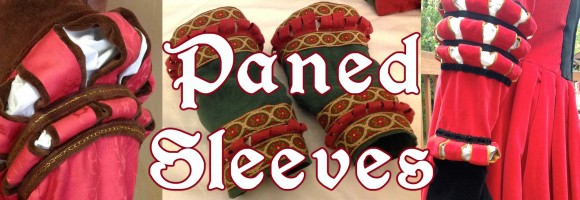The steuchlein is quintessential headwear for 16th c. German women of virtually all classes. You see steuchlein on Landsknecht trossfrau, farmer’s wives, and burger’s wives—in other words, married German women. I am wearing a steuchlein in the image on the right. A steuchlein is composed of four parts: Umbinderlein – linen strip at hairline Unterhauben – linen undercap Wulst – round… (more…)
Category Archives: Construction
German Split-Brim Beret Hat Tutorial
One of the iconic German hats seen in paintings and woodcuts is an oversized, brimmed hat with cuts/overlaps in the fold of the brim. They appear frequently in Cranach paintings, for example. To my knowledge this hat has no name, so I’m naming it the German Split-Brim Beret! Knitted versions of this hat, or ones very like it, appear in… (more…)
German Wams Pattern Based on the Alpirsbach Doublet Find
My son needs a new wams (doublet). He’s been happily wearing two doublets for the past three years, but they were made from commercial patterns and it’s time to see if he’ll go for something more historically accurate (he’s nearly 10 years old, so the days of dressing him in clothing he does not like are over). And I just… (more…)
Dorothea’s Pleatwork Hemd Smock with Cord Tufts and Tassels: Pattern & Gathering Tutorial — Part 1
When I began my adventure down the rabbit hole to 16th century Germany, the first image that really captured my interest was Dorothea Meyer in her 1515 painting by Hans Holbein. Her intricately pleated hemd (smock/shirt) with the little tufts and tassels was just fascinating to me. I set out then to learn how to pleat linen (what we mundanely… (more…)
Paned or “Puff and Slash” German Sleeves: One Method For a Less Frayed, More Complete Look

Paned or “slashed” sleeves are seen on many German Renaissance garments. The simplest method of achieving this effect is to simply cut your sleeve material in straight lines (on the bias) and then bunch the fabric up onto your arm. I’ve done this with the red wool on my black tie-on sleeves. But, I wasn’t entirely pleased with it. The… (more…)
Honeycomb Pleatwork Apron Tutorial Video
As I promised my students at Coronation and the folks on the German Renaissance Facebook page, I’ve made a short video of how to make do simple honeycomb pleatwork. This is made from the video I took while I was making the white apron with the 1″ pleats, so it’s quite easy and I was able to complete it in… (more…)
Mary of Hapsburg’s Hemd: Chemise Pleatwork and Pattern Darning Notes
One of the few extant pieces of early 16th century female garb (1521) remaining today is Mary of Hapsburg’s wedding dress. Mary was the granddaughter of Holy Roman Emperor Maximillian. The gown and chemise are housed in the Hungarian National Museum. The hemd (chemise) may or may not go with the gown (according to museum docents), but it is believed… (more…)
German Landsknecht Beret (a.k.a. The Starfish Hat)
Of the many hats worn by Germans in the 16th century, the beret — often called the Starfish hat by enthusiasts — is one of the more iconic. It’s nickname comes from the broad loops that are arrayed around the hat like, well, a starfish I suppose. Another version of the beret, known as the schlappe, has ear flaps as… (more…)